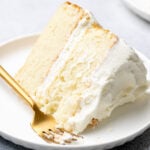Gluten Free Cake Recipe
This light, airy gluten free vanilla cake is for birthdays, special occasions, & everyday moments. Doesn't taste like gluten free cake!
Servings: 8 people
Equipment
- Stand mixer or hand mixer
Ingredients
- 2 cups all purpose gluten free flour blend (I used Better Batter; you must use one of my recommended blends, measure by weight, and sift or the recipe won't work)
- 1 teaspoon xanthan gum omit if your blend already contains it
- 6 tablespoons cornstarch replace with 6 tablespoons additional Cup4Cup if Cup4Cup is your all purpose gluten free flour
- ½ teaspoon baking soda
- 2 teaspoons baking powder
- ½ teaspoon kosher salt
- 4 egg whites at room temperature
- 1 egg at room temperature
- 1 ⅓ cups buttermilk at room temperature
- 2 teaspoons pure vanilla extract
- 10 tablespoons unsalted butter at room temperature
- 1 ½ cups granulated sugar
Instructions
- Preheat your oven to 350°F. Grease 2 8-inch round cake pans and line the bottom of each with a round of parchment paper (trace the perimeter of the cake pan on the parchment, then cut out the circle). Set the pans aside.
- Into a medium-size bowl, sift (yes, you have to sift!) the gluten free flour blend, xanthan gum, and cornstarch. Add the baking soda, baking powder, and salt, and whisk to combine well. Set the dry ingredients aside.
- In a large measuring cup or medium-size bowl, place the egg whites and egg, buttermilk, and vanilla. Whisk to combine very well. Set the wet ingredients aside.
- In the bowl of a stand mixer fitted with the paddle attachment or a large bowl with a handheld mixer, beat the butter and sugar on medium-high speed for at least 3 minutes, stopping at least once to scrape the entire mixture off the sides and bottom of the bowl, or until very light and fluffy.
- To the large bowl with the butter and sugar mixture, add the dry ingredients in 4 equal portions, alternating with the buttermilk and egg mixture in 3 parts, beginning and ending with the dry ingredients and mixing to combine in between additions.
- The batter will sometimes look a bit curdled. That's normal and not a problem at all.
- Once all the ingredients have been added, beat for another minute on medium speed to ensure that everything is combined, then turn over the batter a few times by hand.
- The batter should be fluffy and relatively smooth, although a few lumps are fine. Do not overmix the batter in an attempt to make it perfectly smooth. It will be relatively thick.
- Divide the batter evenly between the two prepared baking pans and smooth each into an even layer with an offset spatula. Bang the bottoms of the pans flat on the counter a few times to break any large air bubbles.
- Place the baking pans in the center of the preheated oven and bake for 20 minutes. Rotate the pans, and continue to bake until the cakes are lightly golden brown all over, have begun to pull away from the sides of the pan and do not jiggle in the center at all (about another 10 minutes). These tests for doneness are more useful than the toothpick test. Do not overbake.
- Remove the cakes from the oven and allow to cool in the pans for 15 minutes before turning out onto a wire rack (and removing the parchment paper liners) to cool completely before frosting and serving.
Video
Notes
Nutritional information is, at best, approximate. Please use your own calculations if you are relying on it for your health!
Originally published on the blog in 2016. Recipe unchanged; much of the text, most photos, and video are new.
Nutrition
Calories: 498kcal | Carbohydrates: 73g | Protein: 8g | Fat: 19g | Saturated Fat: 11g | Polyunsaturated Fat: 1g | Monounsaturated Fat: 5g | Trans Fat: 1g | Cholesterol: 155mg | Sodium: 462mg | Potassium: 128mg | Fiber: 2g | Sugar: 40g | Vitamin A: 667IU | Calcium: 128mg | Iron: 1mg
